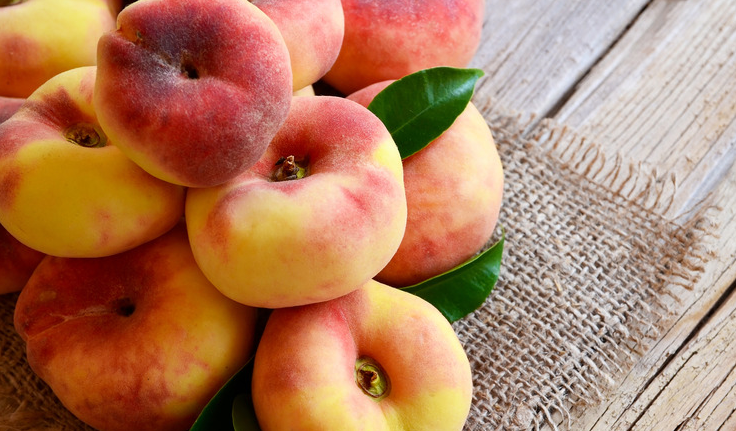
Peaches are botanically classified as Prunus persica and are considered “stone fruits,” and are closely related to apricots, plums, cherries and almonds. There are hundreds of varieties of peaches, including heirloom varieties and hybrid crosses. Peaches come in two different types, yellow-fleshed or white-fleshed and are identified as either freestone or clingstone, signaling to whether the fruit’s pit hugs its flesh or is easily removed.
As the name suggests, Saturn peaches are flatter than regular peaches, somewhat resembling a doughnut (flat with a sunken center rather than round) or, humorously, the planet Saturn with its rings. They are pale-yellow or white-fleshed. They are also known as the doughnut/donut peach. This variety of peach originated in China, where flat peaches have been cultivated for centuries. They were introduced to the U.S. in the 19th century but have seen a resurgence in popularity more recently.
Donut peaches usually are clingstone or semi-clingstone fruit, which means that the pit inside is either partially or entirely attached to the flesh .These peaches are usually sweeter than other peaches, but still have a recognizable peach taste. They are said to be more complex-tasting and flavorful, often described as possessing undertones of almond. The texture is less fuzzy than traditional peaches, which makes them quite palatable to those who dislike the fuzz on regular peaches.
Saturn peaches are grown in various parts of the world now, including the United States, particularly in California, and in Europe. They require similar growing conditions to other peaches but might be slightly more finicky about their care. They are hardy in U.S. Department of Agriculture plant zones 5 to 10.
These peaches are usually available in the summer months, depending on the region. They might be found in specialty grocery stores or farmers’ markets due to their somewhat niche appeal compared to traditional peaches.
Saturn peaches can be sliced for fruit salads or tossed green salads or used for canapes or hors d’oeurves. They are blended into smoothies or milkshakes, or juiced for beverages, cocktails, vinaigrettes or dressings. The tart flavor of donut peaches pairs well with blue cheese, garlic, scallions, lemon, olive oil, celery, and salad greens. Before consuming Green peaches, prick their firm flesh with a toothpick or knife so they can better absorb flavors.
Cultivation
Choosing the Right Location
Saturn peaches, like most peach varieties, require full sun to produce the best fruit. Choose a location in your garden where the tree will receive at least 6 to 8 hours of direct sunlight daily. The site should also have well-draining soil, as waterlogged roots can lead to root rot and other diseases. If your soil is heavy clay or doesn’t drain well, consider amending it with organic matter or planting your tree in a raised bed.
Planting
Plant your Saturn peach tree in early spring or fall when the tree is dormant. Dig a hole twice as wide and just as deep as the root ball. Place the tree in the hole so that the graft union (the noticeable bump on the lower trunk) is about 2 inches above the soil level to prevent rootstock suckers. Backfill with native soil mixed with some compost for a nutrient boost. Water thoroughly after planting to settle the soil around the roots.
Watering
Young trees need regular watering to establish, but once established, Saturn peach trees are relatively drought-tolerant. Water deeply once a week during dry spells, more often in sandy soils or extreme heat. However, reduce watering as the fruit ripens to enhance sweetness; too much water can dilute the flavor.
Pruning and Thinning
Pruning is crucial for peach trees. In late winter or early spring, prune your Saturn peach to an open center shape, which allows light and air to penetrate the canopy, reducing disease and improving fruit quality. Remove any dead, diseased, or crossing branches. After the tree has fruited, thin out the peaches when they are about an inch in diameter. Leave about 6 to 8 inches between fruits to ensure they grow to a good size without branches breaking under weight.
Fertilization
Fertilize your Saturn peach tree in early spring with a balanced fertilizer, following package instructions for fruit trees. Over-fertilization can lead to excessive leaf growth at the expense of fruit quality. A soil test can guide you on specific nutrient needs.
Pest and Disease Management
Saturn peaches can be susceptible to pests like aphids, scale, and peach tree borers, as well as diseases like peach leaf curl, brown rot, and powdery mildew. Use integrated pest management (IPM) strategies: encourage beneficial insects, use horticultural oils or insecticidal soaps for pests, and apply appropriate fungicides early in the season for fungal issues. Ensure good air circulation through proper pruning to minimize disease.
Harvesting
Saturn peaches are typically ready to harvest in mid to late summer. They’re ripe when they give slightly to gentle pressure and have a sweet aroma. Because of their flat shape, they might not always color uniformly, so go by feel and smell rather than color alone. Handle them gently as they bruise easily.
Winter Care
Although Saturn peaches are hardy, in regions with harsh winters, protect the base of young trees with mulch to insulate the roots. However, ensure the mulch does not touch the trunk to prevent rot.